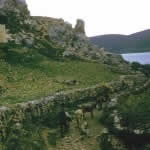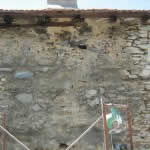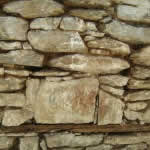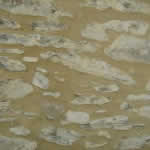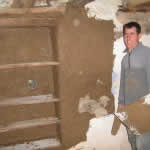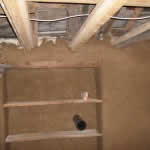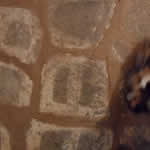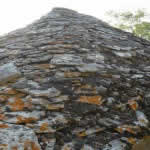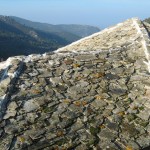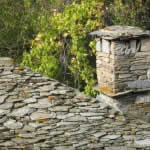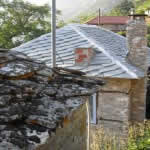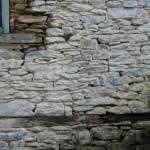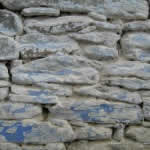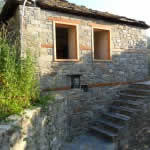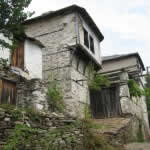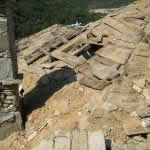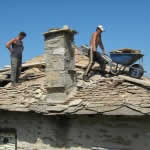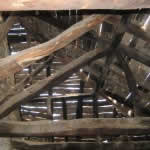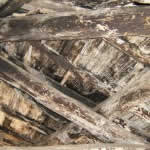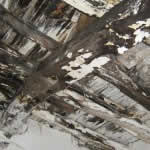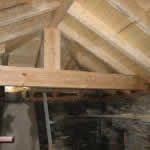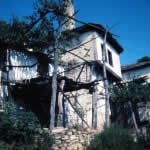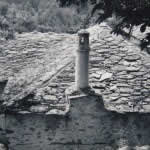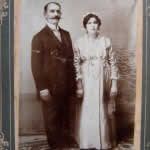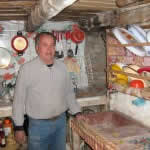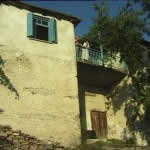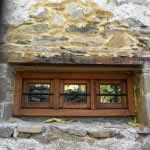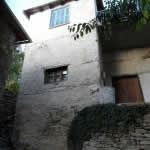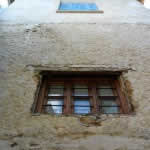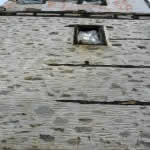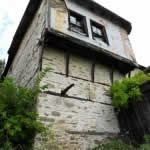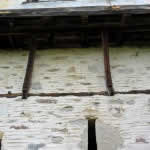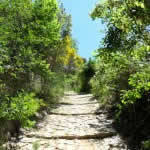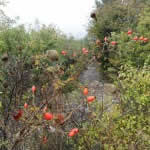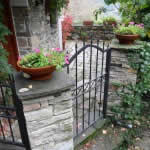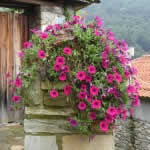When I first arrived at Kazaviti in summer 1973, the entire panorama of the village still presented a purely traditional picture. My photographs of 1973 and 1974 are now historical documents (# 23, 24). It took several decades for the solid structures of the old dwellings to gradually fall apart – proof of excellent craftsmanship and selected building materials which cannot be found anymore, especially the matured, rezin-rich pine and chestnut beams, cedar wood (juniper) rafters and broad boards split from a tree trunk by wedges, not sawn (cf. the article Rural building traditions on Thasos, northern Aegean Sea) We have collected samples of all the materials used traditionally, for a future museum. Sadly, we had to work against the chain-saw mentality of an ignorant majority of residents who consider these irreplaceable, admirably hewn, cut and split up, still very sound timber just as firewood.
The best chances for survival had those buildings, whose stone slate roofs were replaced by industrial tiles. Family inheritance feuds prevented even urgently required measures of repair in several cases. I had to witness the agony of decay of individual properties ever since I became a resident of Kazaviti.
Following the motto: The most efficient preservation is guaranteed by exchange of purchase contracts, I acquired since 1978 a total of 16 roofed houses plus 7 ruins and large plots of garden- and woodland, with the scope of strictly keeping entire units of architectural heritage and their physical surroundings in their original condition. At present 4 houses are inhabitable; my limited funds were not sufficient to make up more; the task of recent years was preservation of the acquired properties in the substantial condition they were when purchased.
It will be in the experienced and caring hands of my son Matthias – a civil engineer – to continue this challenging task and make real earlier dreams.
In our project on Thassos we intend to safeguard and restore all accessible and retainable qualities of old buildings and their rural environment and to introduce visitors to this village scene as it used to be in bygone times. Our guests will sense these traditions in their functions as valued recreational agents, giving lasting wellness and rich experiences to remember.
Clearly such undertaking reaches beyond the capacity of private investment. Considering the significant benefits for the public we do anticipate a substantial participation by the respective government departments and adequate consideration by European support programmes.
A forthcoming new website will accomplish and coordinate the project’s tasks and relate to other relevant aspects for the entire island of Thassos.
Captions:
# 1 Ancient road on Skyros Island (Kalamitza Bay), 1958. Relates to the Open Letter on page 2.
# 2 – # 4 Former monastic mansion (metochi) of the I. M. Xeropotamou, Mt. Athos, at Kazaviti, dated 1806,
Defacing the historical exterior by removal of original lime mortar, replacing by cement. Ventilation breathing) of the wall terminated. Beige pigment added to mortar to pretend antiquity.
# 5,6 Rendering internal wall with a thick layer of clay, house Kyranastasis, Kazaviti
# 7 Refitting original slate floor by using clay, kitchen of house Kyranastasis, Kazaviti
# 8 Original slate roof of house Lazaridis, Kazaviti. Will be replaced by new slate (cf. # 12)… one of the most ancient roofs in the village is going to be demolished – is there any reason why…
# 9,10 Original slate roof of house Karavousis, Kazaviti.
# 11 Original roof of house Kanatsoulis, Kazaviti.
# 12 New slate from Elefteroupolis on the mainland.
# 13 – # 15 The historical facade – painted uncounted times – now hidden behind a modern faceless wall (house Lazaridis, cf. # 8). The was no need, no sound reason for these defacing works.
# 16 – #19 Former monastic mansion (metochi) of the I.M. Esfigmenou, Mt. Athos, at Kazaviti, dated 1807.
Removing heavy roof cover of slate embedded in clay, on (mostly) split pine boards. Restoration of wooden roof construction (chestnut, rezin-rich pine, juniper ) – still solid after 200 years; only using some equal material salvaged from other, collapsed buildings.
# 20 Preserved original wooden roof construction of a family house at Kazaviti.
# 21, 22 Demolition of original wooden roof construction and replacement by new sawmill timber, house Giantsos at Kazaviti.
# 23 House Manola, former mansion of the Athos monastery Esfigmenou, at Kazaviti, photographed 1973.
# 24 House Zografou at Kazaviti, photographed 1973/74.
# 25 Sample from a collection of old photographs found in the house Kyranastasis, Kazaviti.
# 26 Interior in Kazaviti 2009
# 27 The tower house Samiotis 2008, prior to the works discussed on page 4.
# 28 – # 30 The new, out of place basement windows, 2010, as discussed on page 4.
# 31 – # 33 Original window positions, tower house Manola.
# 34, 35 Living fences along the walkway in the upper quarter of Kazaviti; not to everybody’s liking (cf. page 4).
# 36 – # 38 „Embellishments“ of Kazaviti; suburban and not village style…
